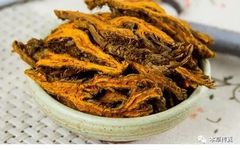Huang Lian (Coptis chinensis) is the rhizome of the plants belonging to the Ranunculaceae family, including Huang Lian (Coptis chinensis), San Jiao Ye Huang Lian (Coptis trifolia), or Yunnan Huang Lian (Coptis deltoidea). Huang Lian is a perennial herb that primarily grows in the high-altitude mountainous regions of western Sichuan, hence it is also known as Chuan Lian (川连). Huang Lian prefers to grow in cold, damp places, mainly distributed in the shaded areas of high mountains at altitudes of 1000-2000 meters, where the average annual temperature is around 10 degrees Celsius, with abundant rainfall and high humidity. In such environments, Huang Lian grows relatively short, with the entire plant reaching about 20 centimeters in height, appearing somewhat frail.
The leaves of Huang Lian are all basal, with slender petioles emerging directly from the ground, topped with three small leaflets, the middle one being slightly larger than the two smaller ones, all of which are ovate-triangular with symmetrically deep serrations along the edges. The leaves are quite firm, and even in the icy cold of winter, they remain evergreen beneath the snow, showing no signs of wilting. The overall impression of the Huang Lian plant is one of a gathering and storing nature. Huang Lian grows very slowly, taking 5-6 years to be harvested, so the yield of wild Huang Lian is limited; most of the Huang Lian used today is cultivated. The flowers of Huang Lian are yellow, and the rhizome is also yellow, especially the Chuan Lian, whose rhizomes cluster together, resembling chicken feet, hence the name Ji Zhua Lian (鸡爪连). This variety has the highest yield and is the most commonly used in clinical practice.
Huang Lian grows slowly, resulting in a solid structure that is difficult to break by hand. The entire Ji Zhua Lian naturally embodies a sense of tightness and solidity. Therefore, Huang Lian primarily symbolizes a strong gathering and storing nature. Huang Lian mainly grows in cold, damp mountainous areas, preferring a rich soil environment. Its qi is very cold, adapting to the cold growing conditions, and its taste is extremely bitter, which helps to gather and resolve the abundant humidity in its growing environment. The bitter and cold nature of Huang Lian reflects its ability to adapt to the cold and humid environment by suppressing the dampness. Thus, Huang Lian is an excellent herb for penetrating the middle earth and resolving dampness.
Dried Huang Lian has a deep yellow color, and its cross-section is bright yellow; just a small amount of Huang Lian can turn a pot of water yellow. When tasted, Huang Lian is extremely bitter, with the bitterness lingering in the mouth, difficult to eliminate quickly. This also reflects Huang Lian’s strong gathering and storing nature. Therefore, when preparing Huang Lian for consumption, it must be crushed; otherwise, the medicinal properties are not easily released. Due to Huang Lian’s strong gathering power, the clinical dosage is generally not recommended to be too large. Huang Lian is most commonly used to clear heat. Qi stagnation can transform into heat, and heat stagnation should be released. However, Huang Lian is a herb that is stronger in gathering, so it does not truly eliminate heat; rather, its cold and gathering qi temporarily conceals the heat, suppressing it. Therefore, using Huang Lian to clear heat often addresses the symptoms rather than the root cause, and is only suitable for sudden heat stagnation with mild symptoms. A small amount of Huang Lian can gather and suppress the diffused heat, allowing the qi to circulate, leading to self-recovery.
For patients with chronic illness where heat has transformed and stagnation is severe, Huang Lian is not recommended, as its gathering power may exacerbate the stagnation and worsen the condition. In such cases, using Bo He (薄荷) to disperse the heat is much more effective than using Huang Lian to clear it. In clinical practice, when treating the upper and middle jiao heat stagnation, I generally use less than 1 gram of Huang Lian to gently suppress it, ensuring that it does not obstruct the flow of qi. If too much Huang Lian is used, its strong gathering power often traps the qi, leading to qi stagnation and heat transformation, worsening the condition. This is also the reason why prolonged use of Huang Lian can lead to heat symptoms.
The Shang Han Lun (伤寒论) mentions the Da Huang Huang Lian Xie Xin Tang (大黄黄连泻心汤), which only requires soaking in boiling water to extract its effects, aiming to utilize Huang Lian’s cold nature while avoiding its strong gathering power, achieving heat clearance and qi circulation without excessive gathering of pathogens, exemplifying the proper use of Huang Lian. Therefore, when using Huang Lian solely for heat clearance, care must be taken to avoid its strong gathering effect, which may obstruct the flow of qi; the key is to use it in small amounts or soak it in boiling water to avoid prolonged decoction.
When dampness is heavy and transforms into heat, this is the best time to use Huang Lian. Dampness is the qi of the middle earth, so Huang Lian is effective in treating gastrointestinal diseases. The symptoms of damp stagnation in the middle jiao, often seen in chronic gastritis, primarily manifest as bloating and discomfort in the stomach, with difficulty in eating. The three Xie Xin Tang (泻心汤) formulas from Zhong Jing are effective targeted prescriptions. The Xie Xin Tang uses Huang Lian and Gan Jiang (干姜) as core ingredients, with Huang Lian gathering and resolving the damp-heat in the middle jiao, while Gan Jiang warms and promotes the qi of the middle earth. This combination helps to eliminate dampness and promote qi circulation, allowing the stagnated qi in the middle jiao to quickly flow, showing effects generally within half an hour. The ratio of Gan Jiang to Huang Lian needs to be higher for Gan Jiang and lower for Huang Lian, to avoid excessive gathering by Huang Lian, which could obstruct the movement of the middle jiao. In my clinical practice, I often use a ratio of ten to one for Gan Jiang to Huang Lian.
For some patients with severe damp-heat diarrhea or dysentery, a larger amount of Huang Lian is needed for treatment. In these cases, the dampness is heavily stagnated, leading to earth stagnation and wood movement, causing severe pain and urgency, so a lighter dosage would be insufficient to control the condition. At this time, a larger amount of Huang Lian can be used to both gather and resolve the damp evil, as well as to suppress and calm the wood, effectively reversing the condition. Thus, Huang Lian is often used as the monarch herb for treating damp-heat dysentery. The use of Huang Lian in the Bai Tou Weng Tang (白头翁汤) to treat heat dysentery exemplifies this principle.
Due to Huang Lian’s strong gathering power, it is also very effective in calming the wood. Some patients with weak middle earth qi may experience abdominal rumbling and diarrhea with slight changes in diet, leading to prolonged suffering, often diagnosed by Western medicine as irritable bowel syndrome. In such cases, using a small amount of Huang Lian to stabilize the earth qi and calm the wood can yield excellent results. Some experienced practitioners prefer to use Huang Lian roots to regulate the spleen and stomach, which is also the rationale behind this practice. The Huang Lian Xu (黄连须) refers to the fine hairs that grow on the rhizome of Huang Lian, which have relatively milder medicinal properties, making them more suitable for elderly and weak patients.
The Shen Nong Ben Cao Jing (神农本草经) mentions using Huang Lian to treat pain in the female genitalia, which also utilizes Huang Lian’s ability to gather dampness and reduce swelling, as well as to calm pain. This type of condition is often seen in current cases of vaginitis or pelvic inflammatory disease with excessive damp-heat. For patients with profuse, foul-smelling discharge, using Huang Lian and Long Dan Cao (龙胆草) or similar bitter-cold gathering herbs can yield immediate effects.
If damp-heat stagnation is excessive, leading to severe heat and flesh rotting into sores, Huang Lian’s strong gathering power can effectively clear the stagnant heat and gather dampness. The use of Huang Lian powder to treat soaking sores in Zhong Jing is equivalent to treating erosive eczema today, showcasing the effective use of this herb. Later generations have adopted this method to treat various heat-toxicity sores and abscesses, achieving quick and definite results, demonstrating the effective use of Huang Lian. However, when heat toxicity is rampant, relying solely on Huang Lian to eliminate the disease is not advisable. Therefore, when using Huang Lian heavily, it should be during times of excessive dampness and heat; once the condition improves, it is essential to stop to prevent excessive gathering, which could lead to qi stagnation and the retention of pathogens, easily causing a relapse of the condition.
Thus, after using Huang Lian heavily in cases of excessive damp-heat, it is advisable to follow up with warming herbs like Cang Zhu (苍术) to avoid the drawbacks of Huang Lian’s excessive gathering. For patients with severe athlete’s foot, where the toes are wet and rotten, and itch unbearably, using a decoction of Huang Lian and Cang Zhu for soaking can lead to recovery, exemplifying a typical approach that utilizes the strengths of Huang Lian while avoiding its weaknesses.
The characteristics of Huang Lian are similar to those of Bai Dou Kou (白蔻); both symbolize gathering. The difference is that Huang Lian grows in cold and damp places, with a cold and strong gathering nature, while Bai Dou Kou grows in warm and damp areas, with a warm and gentle gathering nature. Huang Lian’s bitterness directly suppresses the heat stagnation in the middle jiao, while Bai Dou Kou’s fragrance promotes the qi of the middle jiao. The flow of qi in the human body is precious, so the dosage of Huang Lian should be small to prevent excessive gathering that could hinder the circulation of qi, while Bai Dou Kou can be used in larger amounts, as its spicy and fragrant properties can effectively promote the stagnation in the middle jiao.
Both Huang Lian and Fu Zi (附子) are produced in Sichuan; Huang Lian is strong in gathering, while Fu Zi is potent in dispersing. Therefore, Huang Lian can temper the nature of Fu Zi, gathering to restrain its dispersing effect. Huang Lian can also resolve the heat toxicity of Ba Dou (巴豆); if Ba Dou causes persistent diarrhea, taking Huang Lian decoction can stop it. This not only utilizes Huang Lian’s gathering to stop diarrhea but also uses its cold nature to resolve the heat toxicity of Ba Dou. Within a region, the nature of one herb must have another herb to temper it, reflecting the harmony of yin and yang in nature.
The Shen Nong Ben Cao Jing states that Huang Lian, when taken for a long time, makes one forgetful. This also speaks to Huang Lian’s gathering nature. Gathering leads to sufficient kidney qi, hence making one forgetful. However, this must be in small amounts over a long period, not in large quantities regularly. For individuals with inherently weak middle earth, long-term use is not advisable, as it may damage the stomach qi.
Let us examine the Shen Nong Ben Cao Jing regarding Huang Lian: Huang Lian is bitter and cold. It is used to treat heat qi, eye pain, injury to the corners of the eyes, tears, brightening the eyes, intestinal dysentery, abdominal pain, diarrhea, and swelling pain in women’s genitals. Long-term use makes one forgetful. The preface states that Huang Lian is primarily used for its cold nature to treat heat qi, while the latter part mentions its bitter taste, which gathers dampness and calms the wood for treatment, allowing for slightly larger dosages to directly address the condition.
猜你也喜欢:
是谁给了地方政府强打疫苗的权力?
明白这一点,再也不怕新冠肺炎!
对中医的无知,让瘟疫害死了多少人!
搞医改为什么不能恢复毛泽东时期的赤脚医生制度!
学点中医,有时可以救命!
中医人一定要懂得这个中药药理才能够准确用药
“国难思良医”,此时应向全国招贤,能者上!
是商业操作,还是哗众取宠?最后都是中医背锅!


